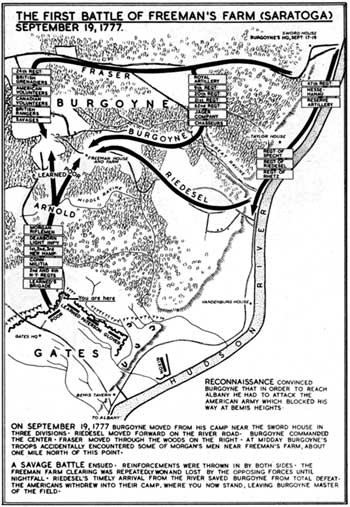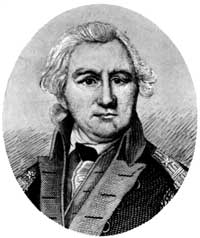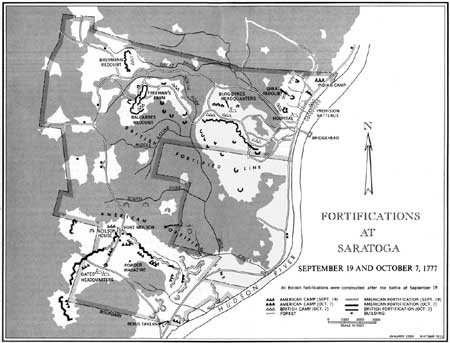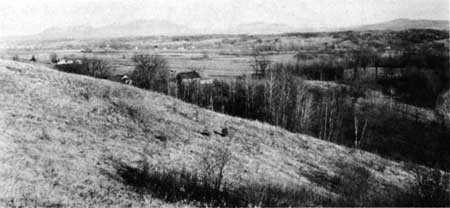|
SARATOGA National Historical Park |
 |

The First Battle of Freeman's Farm (Saratoga)
(click on image for an enlargement in a new window)
The Battle of September 19
It was at this point in the campaign that Burgoyne felt most severely the loss of his Indian allies. After his attempt to discipline the Indians for their brutal murder of Jane McCrea at Fort Edward on July 27, and the two British reverses at Oriskany and Bennington, the Indian nations rapidly began to abandon the royal cause. Up to this time the front and flanks of Burgoyne's army had been covered with an almost impenetrable cloak of savage warriors who had closely harassed the retreating American Army, attacking small detachments and bringing Burgoyne valuable information on American movements. With the loss of his Indian warriors, however, the situation was reversed. Burgoyne was deprived of military intelligence; and, hovering about the Royal Army were hundreds of American scouts who attacked small British units and counted in detail the numbers of men, tents, wagons, and boats in Burgoyne's army.
Thus, on September 19, Burgoyne had little accurate information on the strength or disposition of the American Army that blocked his way to Albany. A heavy fog covered both the American and British camps that morning. While the Royal Army waited for the heavy mists to lift, they prepared to advance in three parallel columns, as they had previously done since crossing the river at Saratoga. Burgoyne's objective that day was to move his army safely forward through the heavy forests to a position near enough to the hidden American camp to enable him to begin effective operations against the American lines.
 Col. Daniel Morgan. Courtesy Fort Ticonderoga Museum. |
 Brig. Gen. Benedict Arnold. Courtesy Fort Ticonderoga Museum. |
Accordingly, on the morning of September 19, Burgoyne moved forward in three columns from his encampment in the vicinity of the Sword House. The right column under Fraser, numbering 2,830 men composed of British and German grenadiers and light infantry, together with the British 24th regiment and the irregulars, advanced along the road running westward from the Sword House to a point 3 miles distant where it then turned south. The center column, consisting of the British 9th, 20th, 21st, and 62nd regiments, was led by Burgoyne. This force, which numbered approximately 1,840 men, followed the route of Fraser for a short distance and then turned southeast at the first fork which led to the Great Ravine. Crossing the ravine, the column then turned westward in an effort to take a position parallel in line with Fraser's column. The left column of about 3,160 men under General Riedesel, consisting of six companies of the British 47th regiment and the German regiments of Riedesel, Rhetz, Specht, and Hesse Hanau, was to advance along the river road accompanied by the heavy artillery, the baggage train, and bateaux. They were to await the signal gun which would indicate that the right and center columns under Fraser and Burgoyne had reached the proper positions. Then, all three columns were to begin advancing toward the American camp until a strong position could be found close enough to it to serve as a base for further operations.
American scouts from the east side of the Hudson detected the forward movement of Riedesel's column along the river road. When Gates was first advised by his scouts of the British advance, he determined to await their attack behind his breastwork. Arnold, however, insisted that the issue should be fought in the field. He reasoned that the forest would not only handicap the British from the standpoint of coordinated attack and the full use of their artillery, but it would also offer a screen peculiarly adaptable to the American style of fighting. If defeated in the field he argued, the troops could then fall back to their entrenchments.
Finally yielding to Arnold's wish, Gates ordered out Morgan's rifle men, supported by Dearborn's light infantry, to reconnoiter the position of the enemy. Moving northward along the road from Fort Neilson Morgan divided his forces in an effort to locate the enemy. The first phase of the engagement opened about 12:30 in the afternoon when a detachment of Morgan's men brushed with the advance guard of Burgoyne's center column in a clearing known as Freeman's Farm. The first volley all but wiped out the British picket. Rushing forward in hot pursuit of the few survivors, the detachment ran head-on into the main body of Burgoyne's center column only to be driven back in turn and widely scattered. By persistent use of his turkey call signal, however, Morgan was able to rally his men and prepare for the second phase of the engagement. Aided by the arrival of the regiments of Colonels Cilley and Scammel from Poor's brigade, he re-formed his line in the woods along the southern edge of the 15-acre clearing.
Forming his line along the northern edge of the Freeman clearing, Burgoyne advanced to the attack with the 21st regiment on the right, the 62nd in the center, and the 20th on the left. Morgan's men suddenly poured such a withering fire into the solidly advancing columns that the British line wavered and fell back across the clearing. Following closely, the Americans were again driven back, as the British quickly rallied their lines.
For more than 3 hours the fighting swayed back and forth across the bitterly contested clearing as each side strove desperately for a decision. Repeatedly the hard-pressed British regiments charged with the bayonet, only to be stopped short by the deadly fire of the American riflemen. Under the skillful direction of Arnold, American reinforcements were so placed as to threaten seriously to outflank the British right. Finally, when the British position had become critical, Riedesel arrived with fresh reinforcements. Throwing his men with great force against the American right, he succeeded in steadying the British line and forcing the Americans to withdraw gradually. But for the arrival of Riedesel, the fate of the Burgoyne campaign might well have been decided here. Approximately 4,000 Americans participated in this fight, while about 5,000 more were held inactive by Gates behind the fortified lines. The attacking American force was opposed through most of the day by the 1,800 British soldiers that composed Burgoyne's center column. It was almost dusk before Fraser's 2,800 men and the 550 German troops under General Riedesel came to Burgoyne's aid.

Fortifications at Saratoga
(click on window for an enlargement in a new window)
The first battle was thus fought under the "fog of war." Because of the great forest which shielded each army from the other, neither Burgoyne nor Gates was sure of the other's dispositions or intentions. General Burgoyne believed that the main American attack was directed against his right and thus held Fraser with the elite troops in reserve. General Gates, on the other hand, was of the opinion that the main British attack was directed against the American right along the river road and therefore held back the 5,000 American troops to defend this key pass. For this reason, the battling columns were reinforced only in a piecemeal fashion by both generals until late in the day. The contestants were thus evenly matched until dusk when Burgoyne finally ordered in regiments from both flanking columns and drove the Americans from the field of battle. The heavy, unknown forest and darkness, however, prevented any effective pursuit.
Stopped in his advance about 1 mile north of the American lines with a badly crippled army, but left in possession of the immediate field of battle, Burgoyne decided to entrench his troops in the vicinity of the Freeman Farm. There he awaited the cooperation of Howe or Sir Henry Clinton, who was then stationed in New York. He also felt the need of reconnoitering the American position as he still knew virtually nothing about it.

View northeast from the American river batteries, showing how
American cannon dominated the narrow river plain and road at this
point.

|

| History | Links to the Past | National Park Service | Search | Contact |
|
Last Modified: Mon, Dec 2 2002 10:00:00 am PDT |

